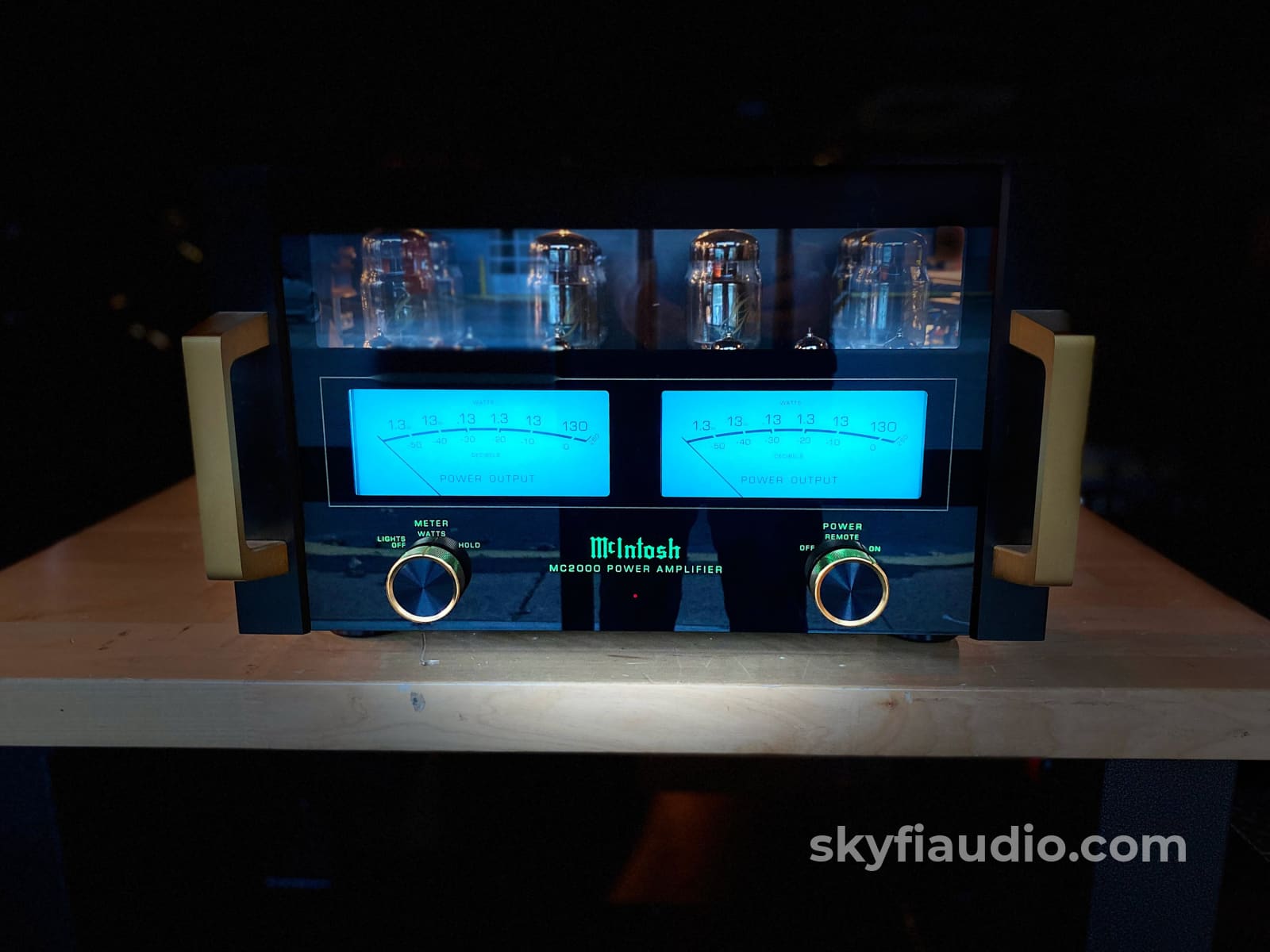

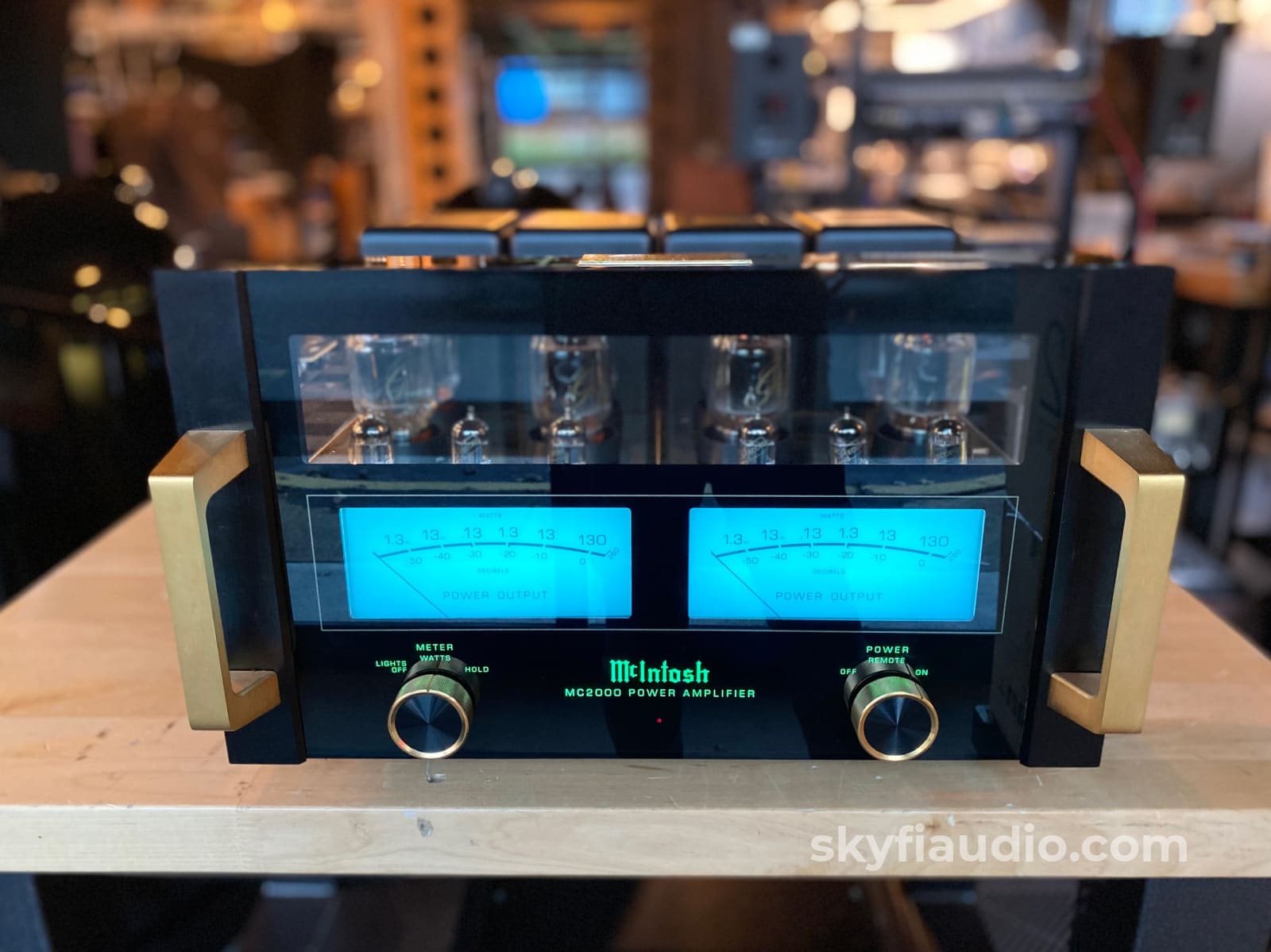

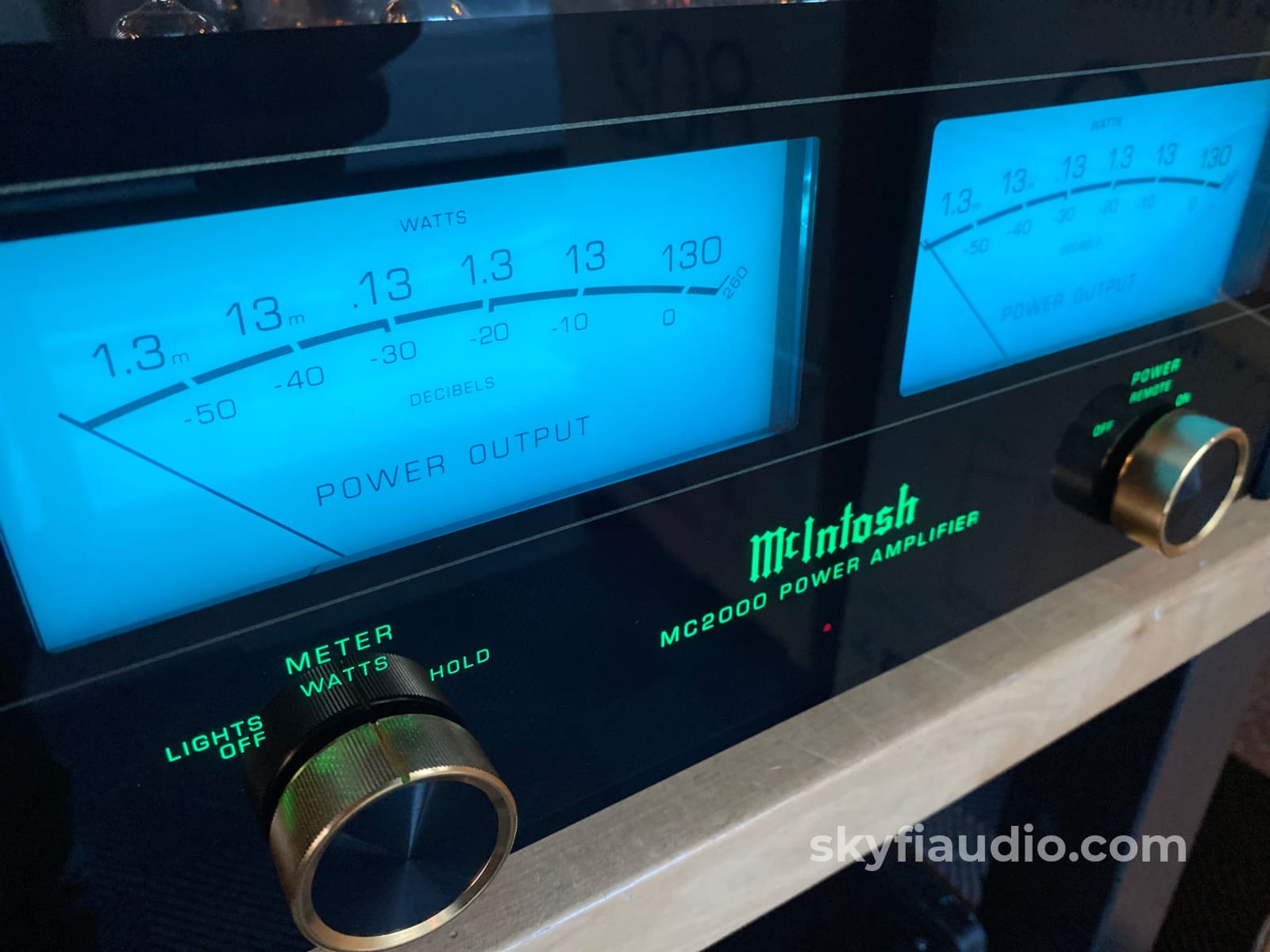
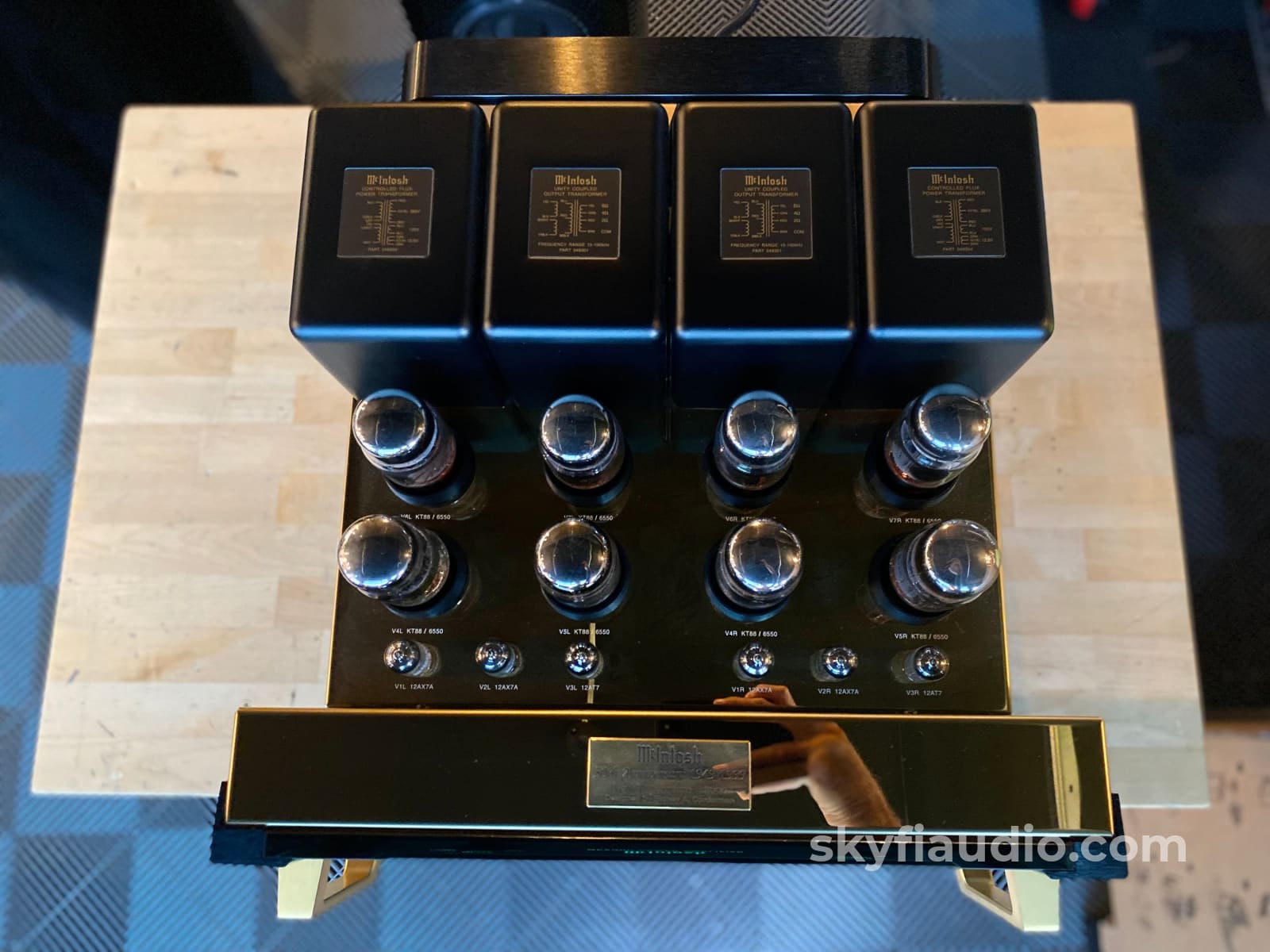
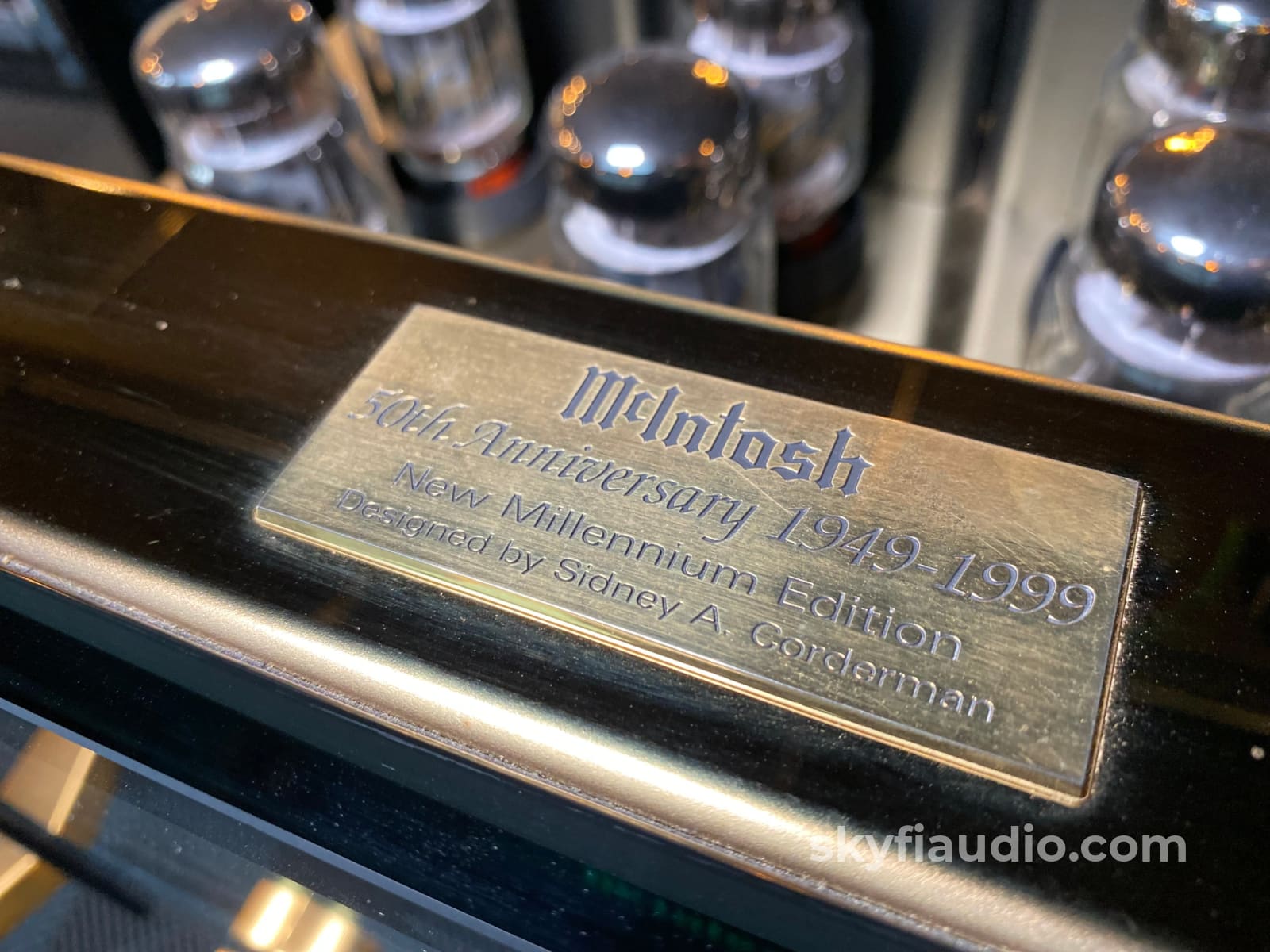
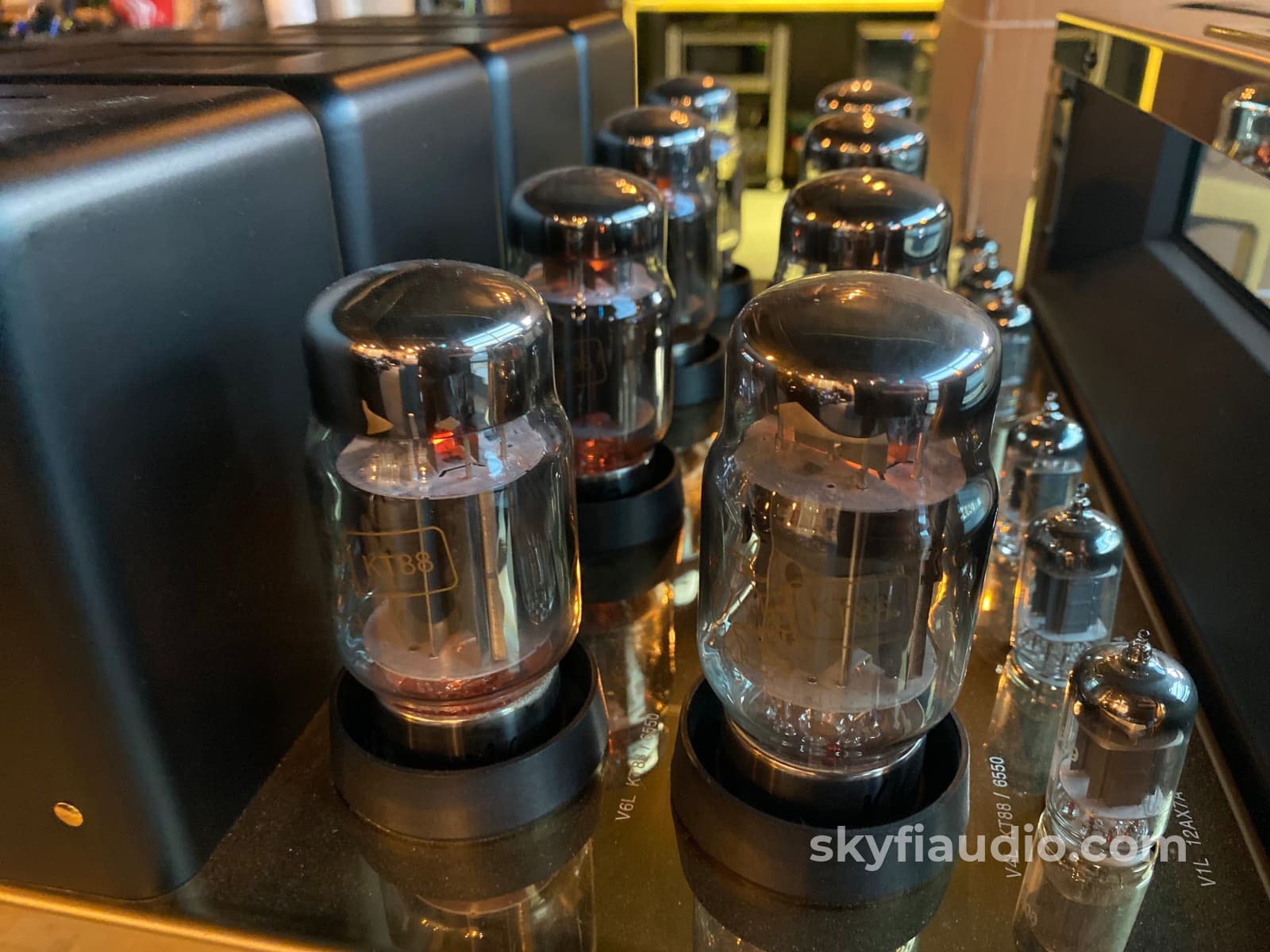
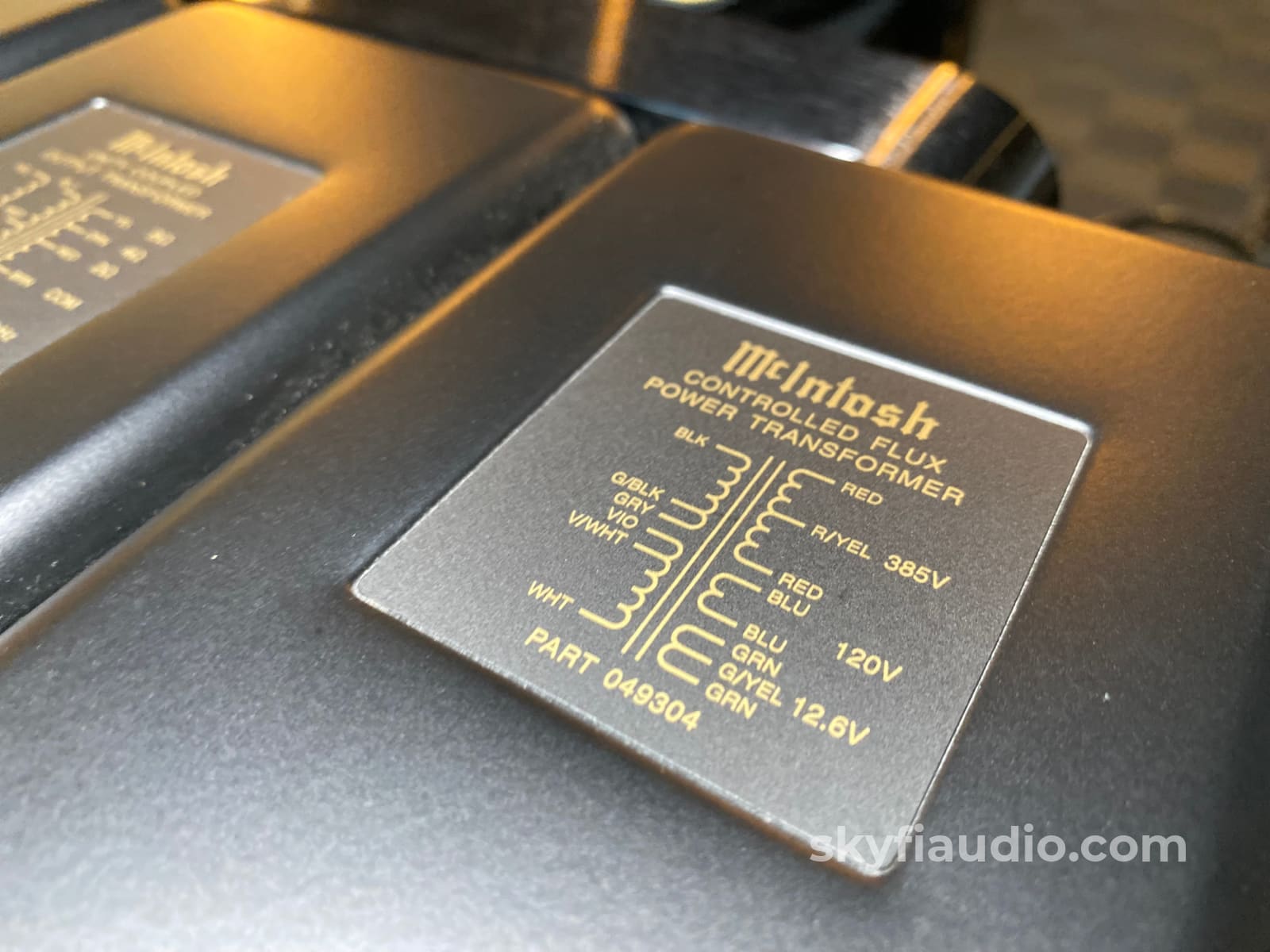
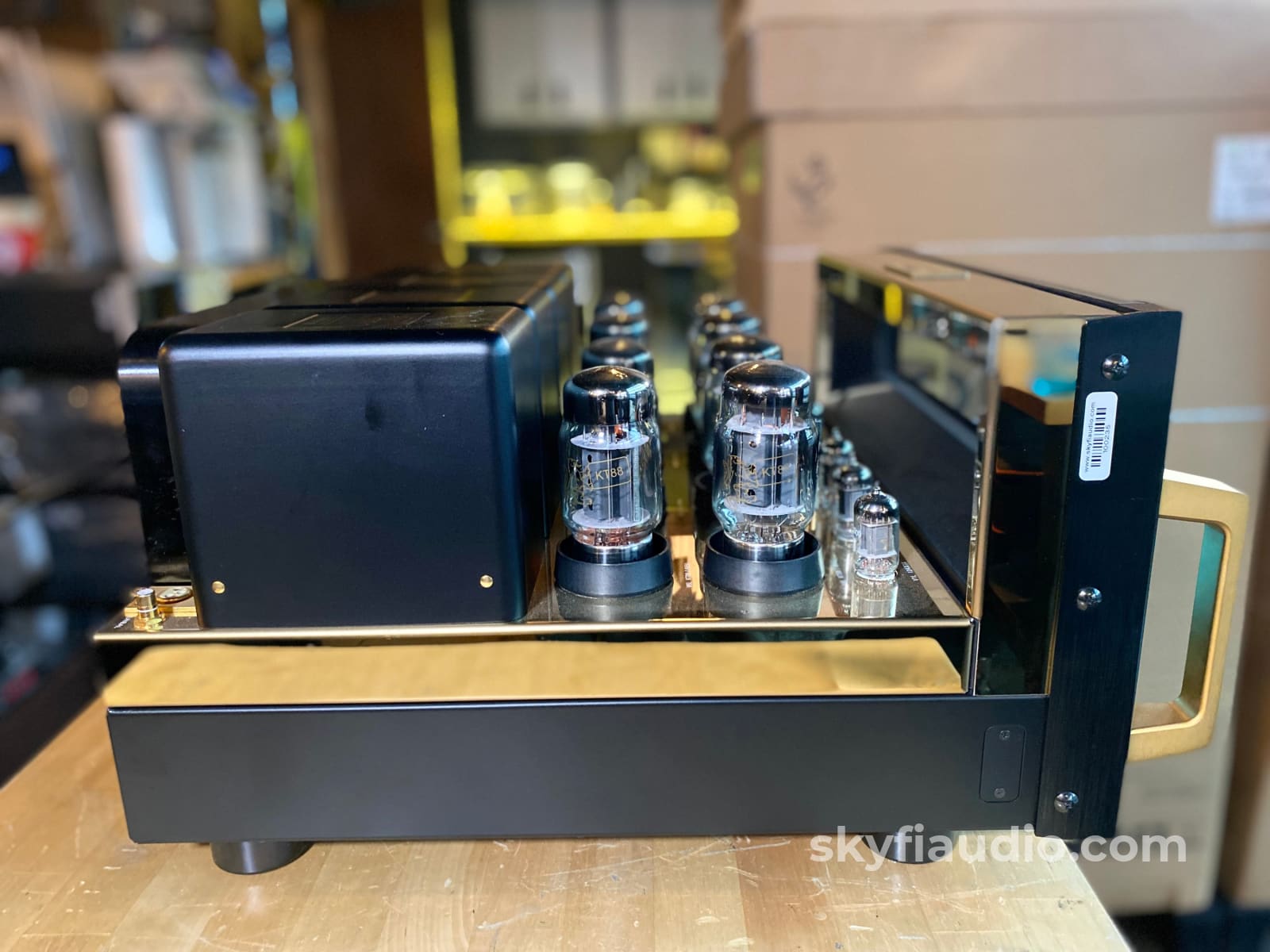
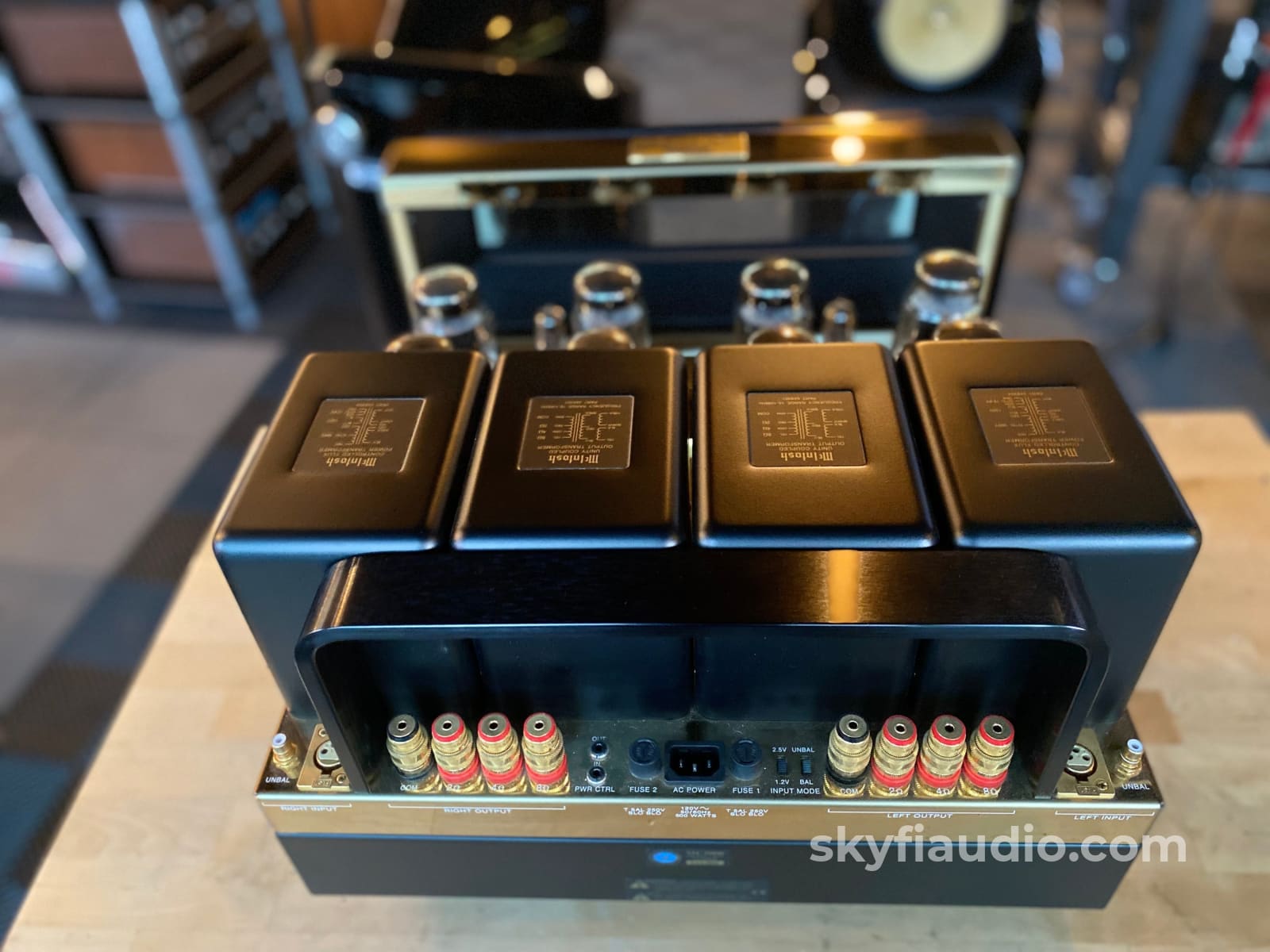
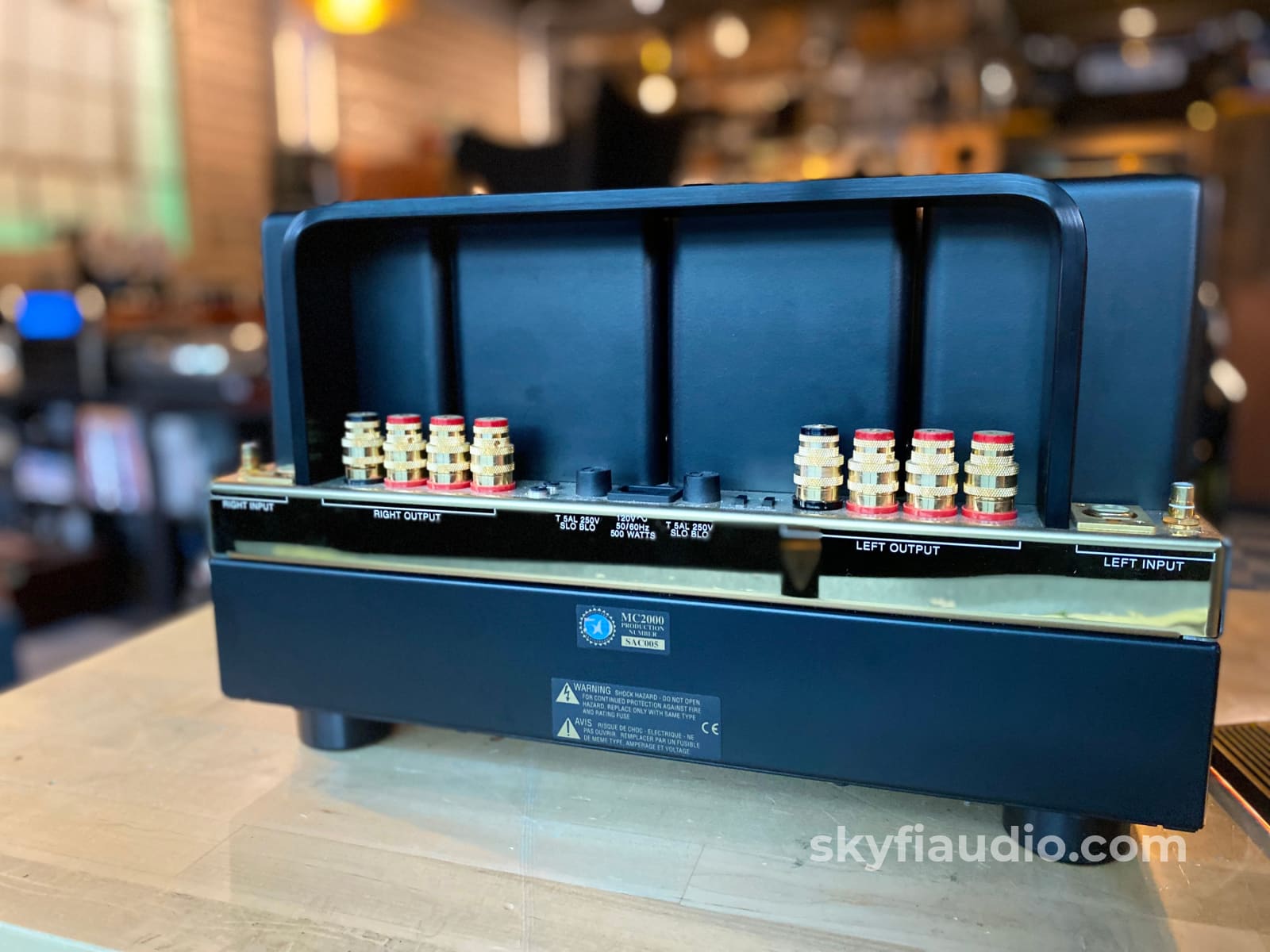
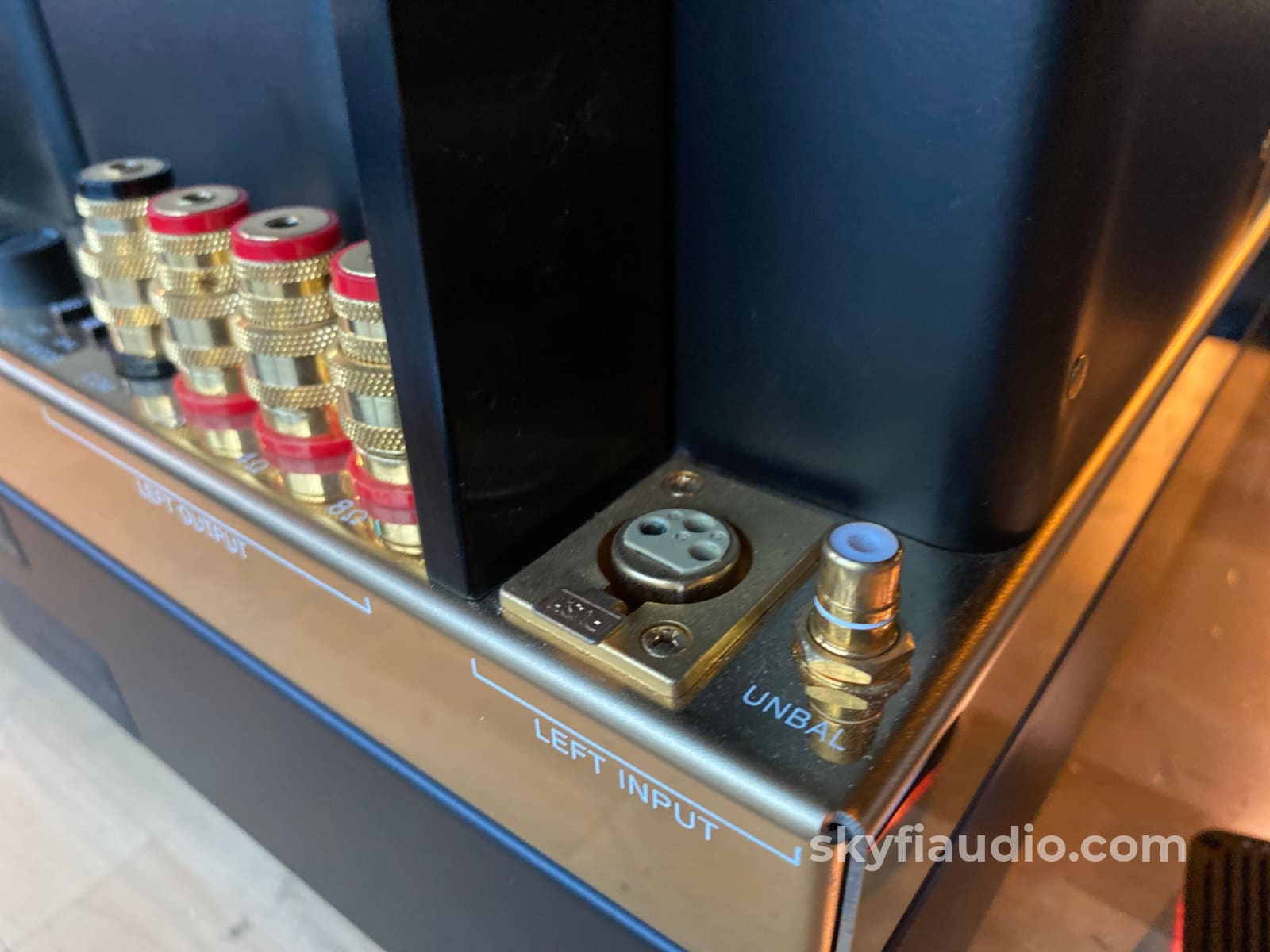
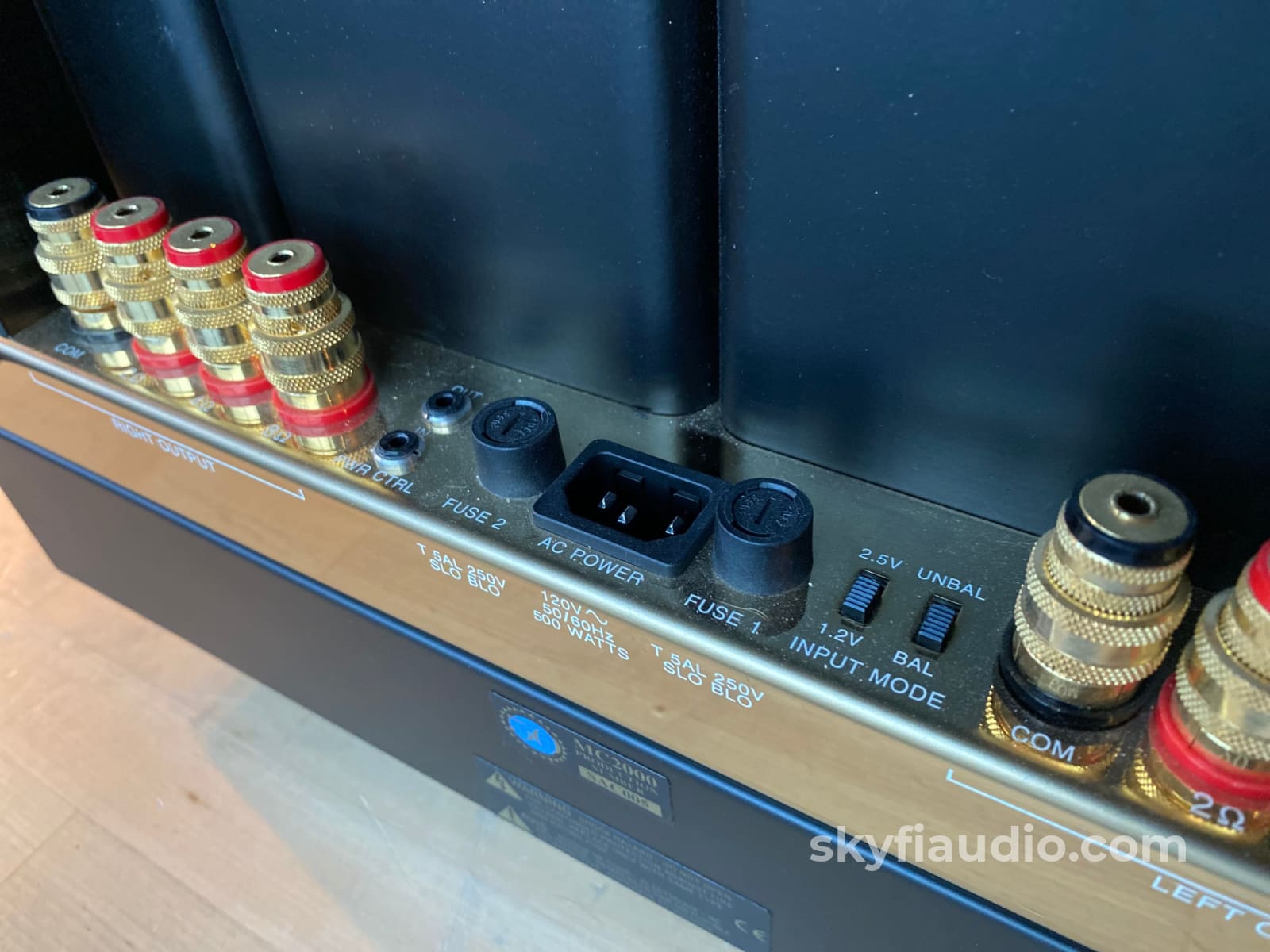
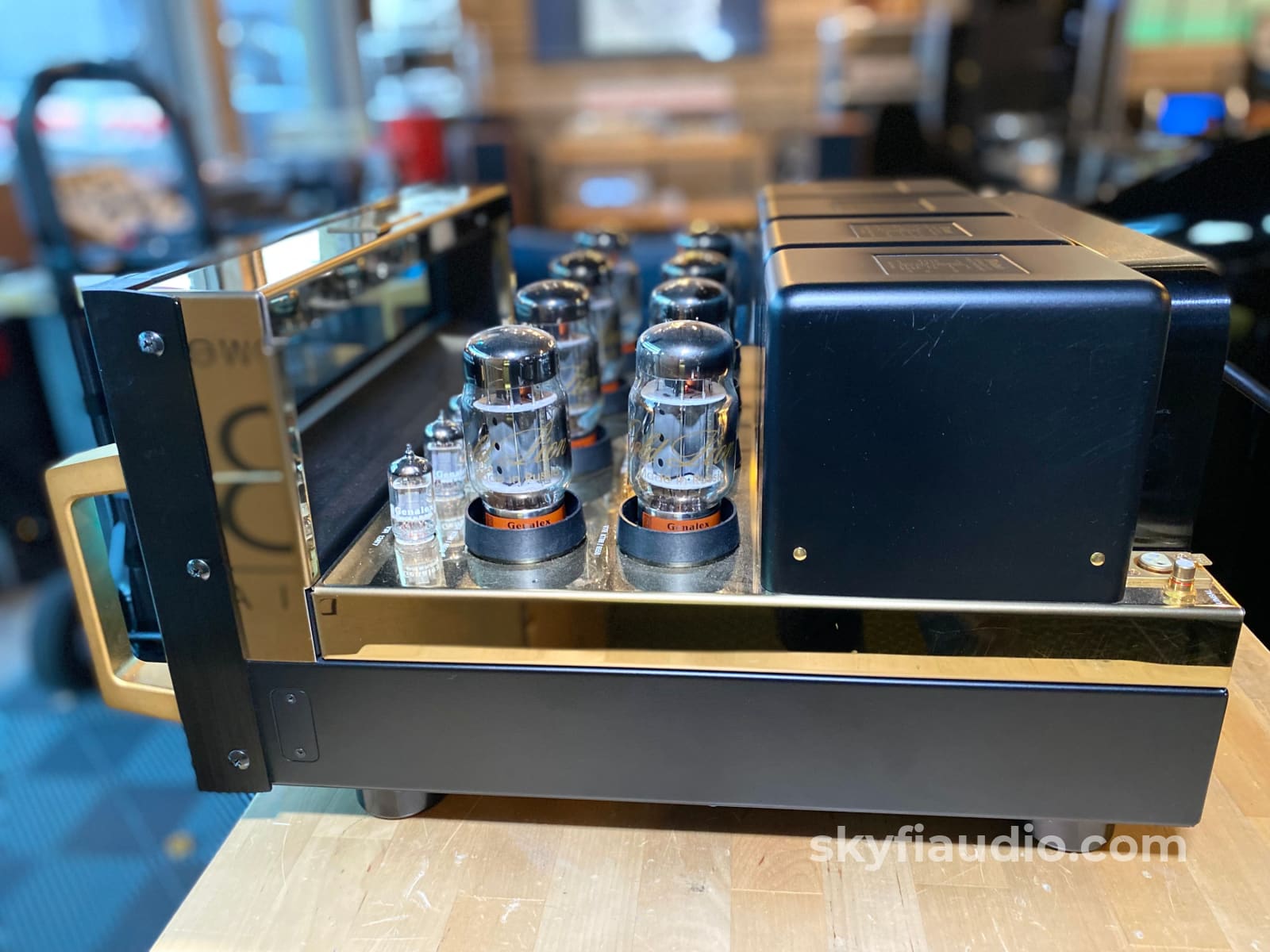
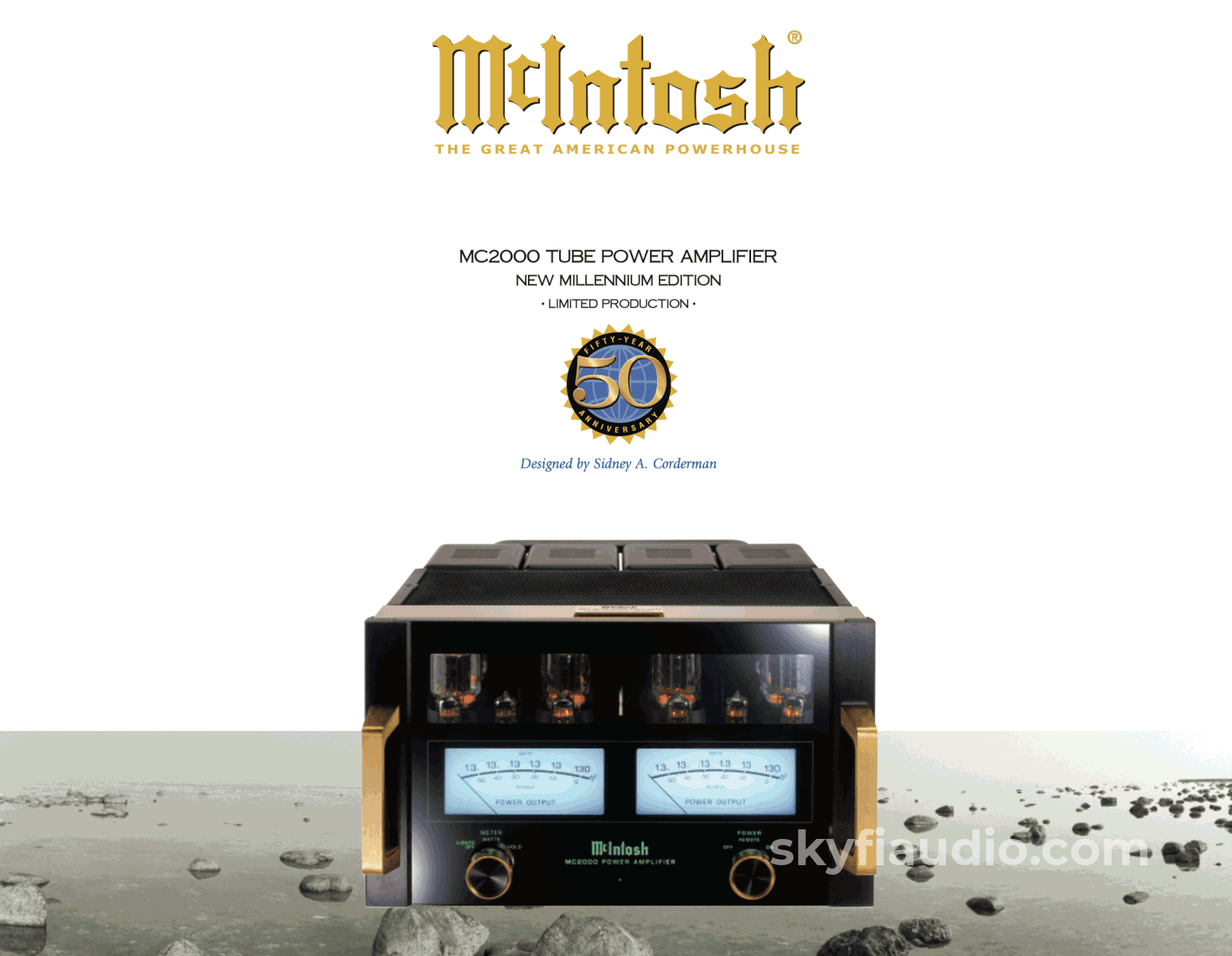
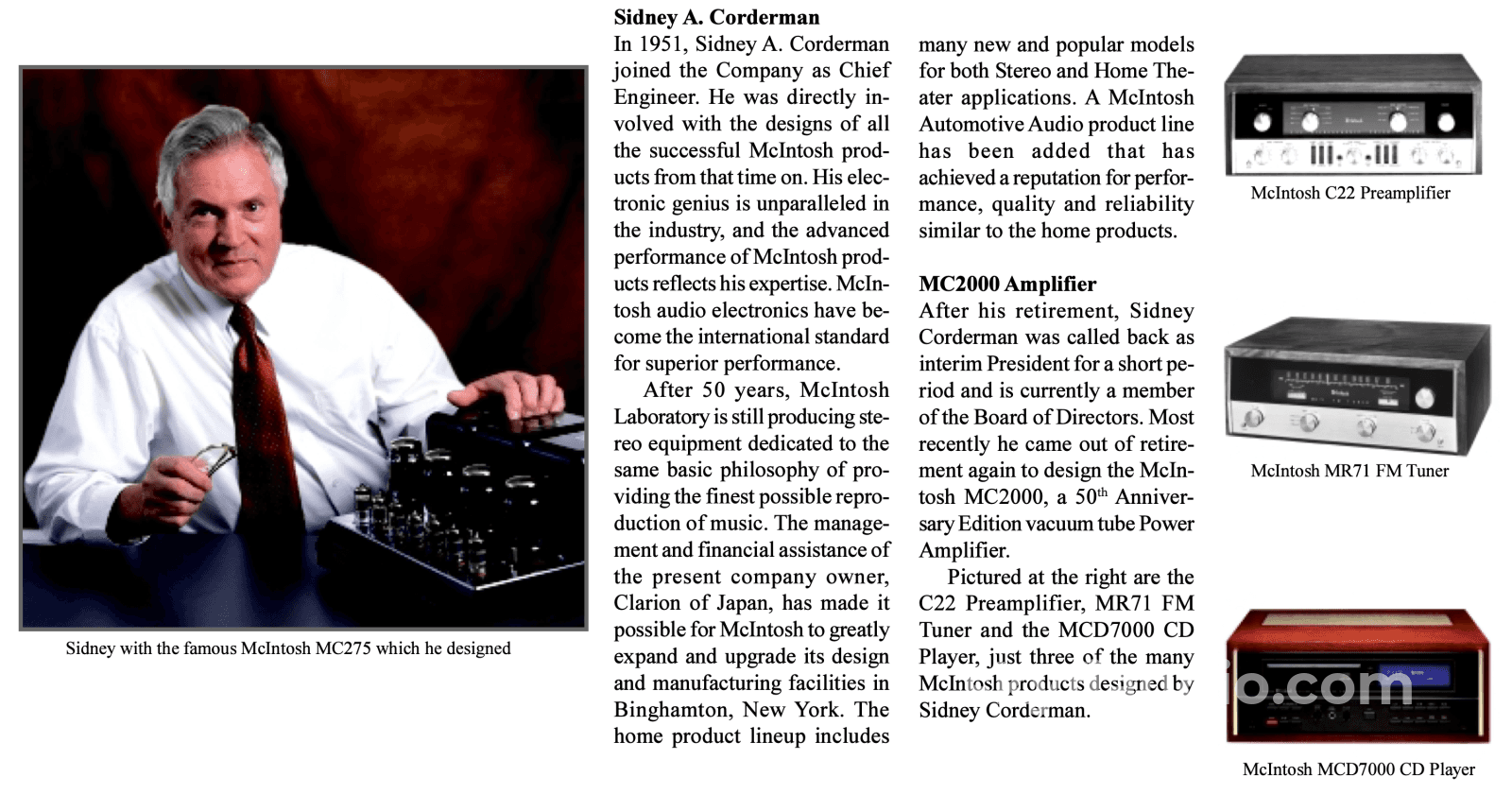
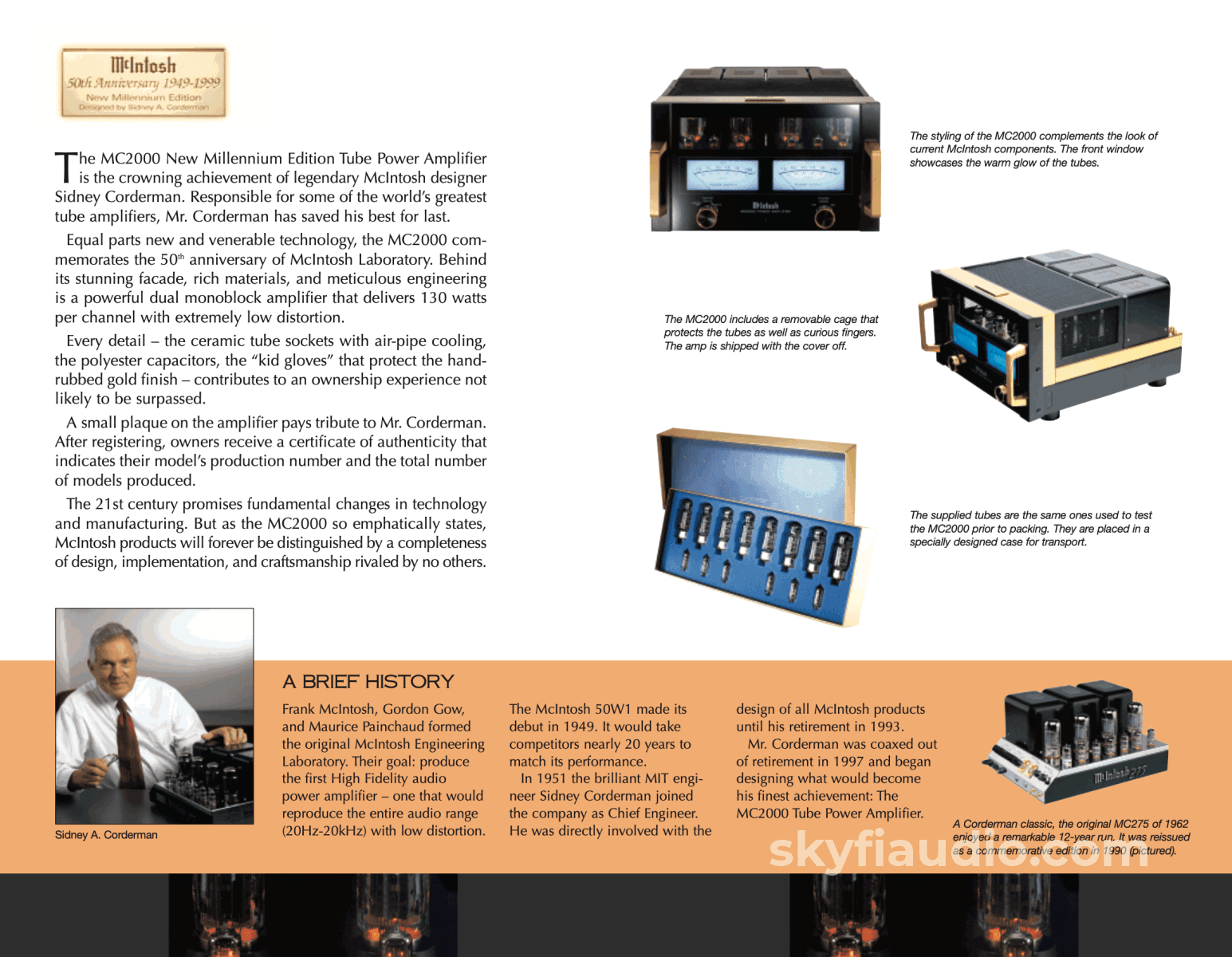
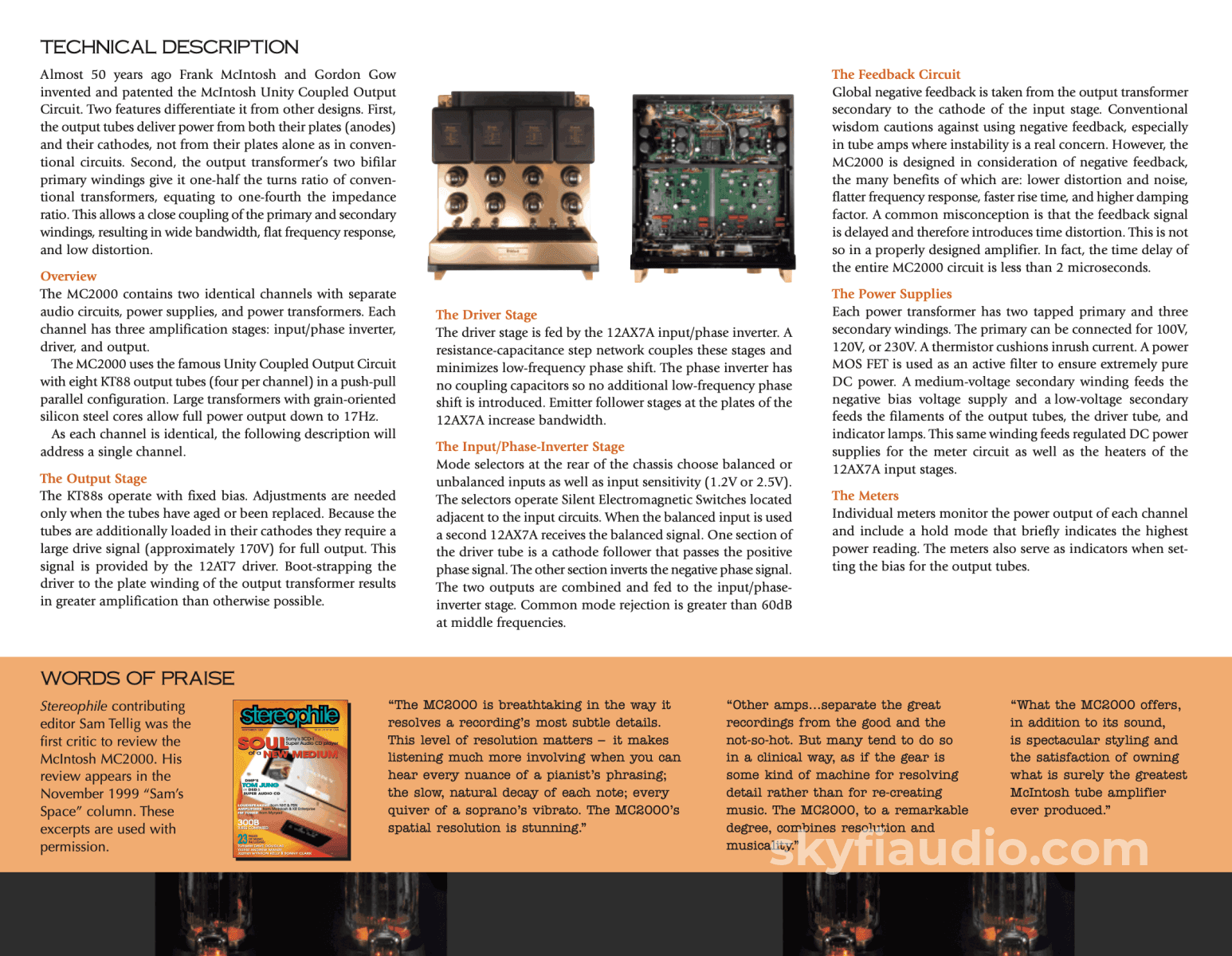

McIntosh MC2000 50th Anniversary Tube Amplifier - Collectors Set
Free Shipping on Most Electronics - Excludes Speakers and Items Requiring Freight - Contiguous U.S. Only
Pickup available at SkyFi 479
Usually ready in 24 hours

McIntosh MC2000 50th Anniversary Tube Amplifier - Collectors Set
SkyFi 479
479 South Broad Street
Glen Rock NJ 07452
United States
General:
The 50th Anniversary MC2000 is one of the rarest and most collectible amplifiers from McIntosh.
If you're lucky enough to visit the factory in Binghamton, you may have spotted one in a glass pedestal in their offices.
Besides collectibility there are many reasons the MC2000 is wonderful:
1) Like many Anniversary models it's gold plated, which makes it unique and gorgeous.
2) It features a traditional McIntosh amplifier layout with large blue meters, not a boring sled design like most tube amps.
3) The glass window in the front allows for a full view of the warm glow of the power tubes.
4) It has more power than the MC275 giving it enough horsepower to drive a more complex and demanding speaker load - 130W per side.
5) It's a dual mono design, featuring two amplifiers in a single chassis.
This particular example comes from my private collection. It's time for it to find a new home and spread the joy.
It has very low use and there are no notable signs of use. The metalwork is clean and shiny, the meters are bright, clear, and responsive.
It's complete with everything like day it left the factory, exactly as you would expect a collector piece to be. MSRP back in 2000 was $15,000 and this rare piece is priced accordingly.
This amplifier and its companion small accessory box will ship strapped to a pallet within the lower 48 US states for $600. Please inquire for international shipping.
McIntosh Performance Features Include:
· Power Output
The MC2000 is a Dual Mono design which consists of two entirely separate Mono, 130 watt vacuum tube power amplifiers, each with its own power supply. Output impedance connections are provided for 2, 4 and 8 ohm loudspeaker loads.
· Patented Bifilar Wound Transformers and Output Circuit
The power output sections utilize the famous McIntosh patented Unity Coupled Circuit with a Bifilar Wound Output Transformer for low distortion, extended frequency response and cool operating output tubes.
· Balanced and Unbalanced Inputs
Both Balanced and Unbalanced Inputs are included. Balanced connections guard against induced noise and allow long cable runs without compromising sound quality.
· Illuminated Power Meters
Two accurate, peak responding output meters continuously indicate the power delivered by each channel. A Peak Hold Meter Mode indicates the maximum power reached over a given time span. The meter illumination can be turned off so as to not detract from the listening environment, if desired.
· Ceramic Tube Sockets with Gold Contacts
Ceramic tube sockets with gold plated contacts provide firm, reliable connections that are not affected by atmospheric contamination. Output tube sockets include Air-Pipe cooling at their bases.
Brand Background:
McIntosh Laboratory is an American manufacturer of handcrafted high-end audio equipment based in Binghamton, New York. The company was founded in 1949 by Frank McIntosh. The company designs and produces audio amplifiers, stereo tuners and other consumer electronics products.
McIntosh is known for offering distinguished home audio systems that deliver the ultimate experience in music and film. Offering products for two-channel stereo sound systems and multi-channel home theaters with surround sound, McIntosh continues to define the ultimate home audio entertainment experience for discriminating listeners around the world. Our iconic blue Watt output meter is globally recognized as a symbol of quality home audio. With a McIntosh home stereo system or home theater, listeners have the ability to create their own luxury audio experience – and truly live their music.
Ownership:
Single Owner
Connections:
RCA and XLR Inputs, 5-way speaker binding posts, IEC power cord, 12V trigger.
General Sound:
Smooth, uncolored, undistorted natural and clean
Cosmetic Condition:
8 - Very Slight Signs of Use
https://skyfiaudio.com/pages/our-rating-scale
Working Condition:
Working perfectly and tested in our lab.
Included:
Everything like when it arrived new.
Packing:
Original Manufacturers Packing
Original MSRP:
$15,000.00
Specifications
Power Output
130 watts into 8, 4 or 2 ohm loads is the minimum sine wave continuous average power output per channel from 20Hz to 20,000Hz with both channels operating.
Total Harmonic Distortion
0.5% maximum harmonic distortion at any power level from 250 milliwatts to rated power per channel from 20Hz to 20,000Hz with both channels operating.
Intermodulation Distortion
0.5% maximum intermodulation distortion if instantaneous peak power output does not exceed twice the output rating per channel with both channels operating, for any combination of frequencies from 20Hz to 20,000Hz.
Rated Power Band
20 Hz to 20,000 Hz
Frequency Response (at 1 watt)
+0, -0.25 dB from 20 Hz to 20,000 Hz
+0, -3 dB from 10 Hz to 100,000 Hz
Hum and Noise (A-Weighted)
100 dB below rated output
Damping Factor
Greater than 18
Output Load Impedance
2, 4 or 8 ohms
Input Impedance
20K Ohms Unbalanced (RCA Phono Jacks)
40K Ohms Balanced (XLR Connectors)
Input Sensitivity (Switch Selectable)
2.5 volts for rated output
1.2 volts for rated output (1 volt for 100 watts output)
Tubes Compliment
8 x KT88 or 6550 Output Tubes
4 x 12AX7A Input Tubes
2 x 12AT7 Driver Tubes
Power Requirement
120 Volts, 50/60Hz at 4.8 Amps
Finish
Stainless Steel Chassis with Titanium Gold Super Mirror Finish, Black Transformer Enclosures, Black Base, Glass Front Panel with gold plated Handles and Knobs
Dimensions:
17-3/4 inches (45.1cm) wide by 11 inches (27.9cm) high. Depth behind front panel is 18-3/4 inches (47.6cm). Handle clearance required in front of the mounting panel is 1-5/8 inches (4.1 cm).
Weight:
• Amplifier: 135 pounds (61.2 kg) net, 144 pounds (65.3 kg) in shipping carton
• Accessories: 18 pounds (8.2 kg) in shipping carton
Approximate Age:
2000
Reviews:
Link to Manual:
McIntosh MC2000 Manual - In Full Color!
Recommended Cables:
Kimber Kable - RCA Interconnects - Best
Kimber Summit Series Monocle XL Speaker Cables (PAIR) - Best
Kimber Summit Series BiFocal XL Bi-Wire Speaker Cables (PAIR) - Best If Applicable
Kimber Kable - Power Cords - Better
Testing Process:
We start with a visual inspection of all internal components to make sure that there are no signs of heat stress or damage. Capacitors are checked for telltale signs of predictive failure including bulging, shrunken wrappers, or physical leakage. We also inspect resistors and other passive components for signs of overheating. If tube arcing has occurred in the past we can usually spot discoloration on the output tube sockets. On vintage units we often spot check select capacitors for value and ESR.
If the amplifier passes visual inspection, we move on to a full test of all of the tubes. We use an Amplitrex AT-1000 Tube Tester which is capable of testing both emission and Gm with a high degree of accuracy. We document the results of each tube and replace any weak or suspect tubes before proceeding. When we power on tube amplifiers for the first time we usually use a variac and current limited AC supply and slowly raise the voltage up to nominal mains level while monitoring plate, screen, filament, and negative bias supply voltages where applicable. If everything is in order we feed a low level test signal into the amplifier’s input and monitor its output on an oscilloscope across an 8 ohm dummy load. At this point we are just looking to verify basic function and confirm that the output transformers are not damaged. Once we have verified that the amplifier is safe to operate, we connected it to full mains power. For fixed bias amps we set the bias to manufacturer spec. For cathode biased amps we monitor the plate to cathode voltage to determine if the output tubes are operating in a safe range. Once the output section is verified we move onto bench evaluation.
We start by feeding the input of the amplifier with a low level 1KHz test signal, slowly increase its amplitude while monitoring the amplifier’s output on an oscilloscope for signs of noise, clipping, distortion, or improper channel balance. We continue increasing the signal level until the amplifier reaches clipping. At this point we take an output power measurement and compare it to the spec sheet of the amplifier to verify proper performance. We finish off the bench evaluation with a 1KHz square wave check and a 20Hz to 20KHz sine sweep to assess the amplifier’s frequency response characteristics. This battery of tests will usually reveal if the amplifier has any issues that need further attention.
Before the device leaves the bench, we perform a listening test with actual music using a variety of preferred test tracks. Our benches are outfitted with familiar monitor speakers which help us identify inconsistencies that will not always show up on our test gear. The main things that we are listening for are hum or noise with no signal present, proper center image, clicks, pops, or any other obvious undesirable audio characteristics.
If the unit passes all of these tests it is moved to our long term testing rig where we simulate real word operating conditions for 6-8 hours. For tube amps we like to run this test at least twice. This allows us to monitor the unit for signs of thermal runaway or intermittent issues that only crop up when it has fully come up to temperature. We find this step to be essential, especially for vintage units.
Specs:
Power Output
130 watts into 8, 4 or 2 ohm loads is the minimum sine wave continuous average power output per channel from 20Hz to 20,000Hz with both channels operating.
Total Harmonic Distortion
0.5% maximum harmonic distortion at any power level from 250 milliwatts to rated power per channel from 20Hz to 20,000Hz with both channels operating.
Intermodulation Distortion
0.5% maximum intermodulation distortion if instantaneous peak power output does not exceed twice the output rating per channel with both channels operating, for any combination of frequencies from 20Hz to 20,000Hz.
Rated Power Band
20Hz to 20,000Hz
Frequency Response (at 1 watt)
+0, -0.25dB from 20Hz to 20,000Hz
+0, -3dB from 10Hz to 100,000Hz
Hum and Noise (A-Weighted)
100dB below rated output
Damping Factor
Greater than 18
Output Load Impedance
2, 4 or 8 ohms
Input Impedance
20K Ohms Unbalanced (RCA Phono Jacks)
40K Ohms Balanced (XLR Connectors)
Input Sensitivity (Switch Selectable)
2.5 volts for rated output
1.2 volts for rated output (1 volt for 100 watts output)
Tubes Complement
8 M KT88 or 6550 Output Tubes
4 M 12AX7A Input Tubes
2 M 12AT7 Driver Tubes
Power Requirement
120 Volts, 50/60Hz at 4.8 Amps
Finish
Stainless Steel Chassis with Titanium Gold Super Mirror Finish, Black Transformer Enclosures, Black Base, Glass Front Panel with gold plated Handles and Knobs
|
Item |
Included |
|
Original Box |
Yes Included |
|
Manual |
Yes Included |
|
Remote |
Not Applicable |
|
Cables |
Yes - Power Only |
|
Physical Condition (Info Here) |
8 / 10 |
|
Working Condition |
10 / 10 |
Choose options




















